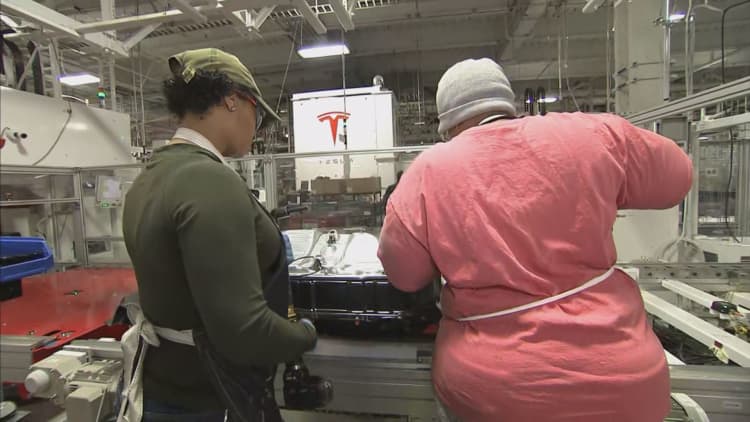
Walk into Tesla's Gigafactory in Sparks, Nevada, and the first thing that stands out is the size of the battery plant. It's enormous. So big that you could fit 33 football fields — and it's only getting larger.
"The Gigafactory is critical to Tesla. There is more batteries produced here for electric vehicles than in the rest of the planet combined. We would not be able to make all the vehicles we are making now if we didn't have the Gigafactory," said Jerome Guillen, president of Tesla Automotive.
The Gigafactory's expansion since opening in July 2016 has been critical to Tesla's growth. This year, the automaker is on track to sell 236,000 vehicles. Much of that growth is due to its latest vehicle, the Model 3, a sedan targeted to a broader audience than Tesla's previous cars. All of the Model 3's batteries are built at the Gigafactory.
Last quarter, as Tesla hit its target of producing more than 5,000 Model 3 cars per week, the company posted a profit. CEO Elon Musk says his company has turned the corner after years of mounting losses.
"We expect to again have positive net income and cash flow in Q4 and I believe, our aspiration certainly will be for all quarters going forward," Musk told analysts during the company's earnings conference call.
Analysts are not so sure. "Part of the real reason they beat in Q3 is because the mix was so strong," said Colin Langan, an auto analyst for UBS who has a sell rating on Tesla. Langan calculates the average Tesla sold for more than $60,000 last quarter, well above the price point Tesla initially promised potential buyers.
"I think long-term the price will probably settle in the mid-forties, where comparable luxury vehicles sell today, and that is going to put a lot of margin pressure on over time," he said.
Easing that pressure and keeping Tesla profitable will come down to a few key factors, most notably, growing sales and lowering the cost to build battery packs. In both cases, the Gigafactory will determine if Tesla succeeds.
Running around the clock, the Gigafactory cranks out approximately two battery packs every minute. Its production is currently estimated to be 5,000 a week, with room to grow, according to Sam Jaffe, managing director with Cairn Energy Research Advisors in Boulder, Colorado.
Jaffe studies the electric vehicle market, specifically focusing on the costs to build the battery packs and cells that provide the energy inside those packs. Jaffe's analysis pegs Tesla's cost to manufacture a battery cell at $116 per kilowatt-hour, which he says is "far ahead of the industry." He estimates other automakers building electric vehicles have battery cell costs closer to $146 per kilowatt-hour.
"Tesla has shown an ability and a drive to reduce both cell costs and battery pack costs," he said. "They have been planning for this moment, with this tremendous cost advantage, for a long time, and in general they have executed well on it."
That's not to say, there haven't been growing pains at the Gigafactory. From having to backtrack on overly ambitious plans to use robotics and automation to allegations the plant is being wasteful, Tesla's battery plant has faced plenty of scrutiny.
Guillen said he believes the Gigafactory is just tapping its potential for battery production.
"The costs have come down and continue to come down a lot and that has enabled us to reach profitability in the last quarter and positive cash flow as well," he said.
Clarification: Tesla's projected sales figure for this year have been updated in this story.
—CNBC's Meghan Reeder contributed to this report.


